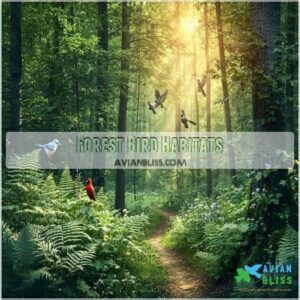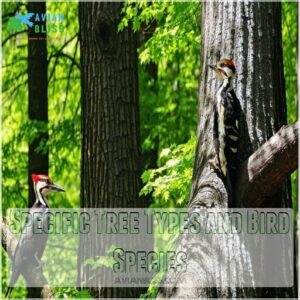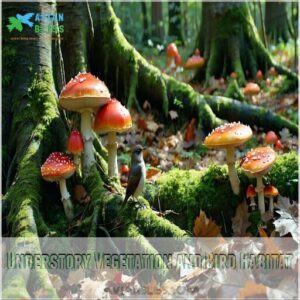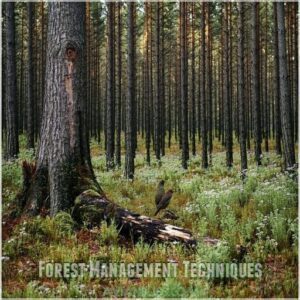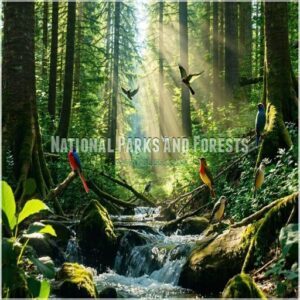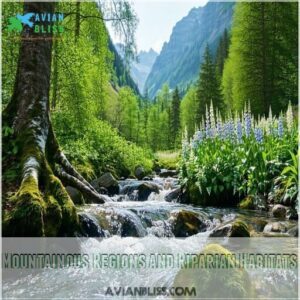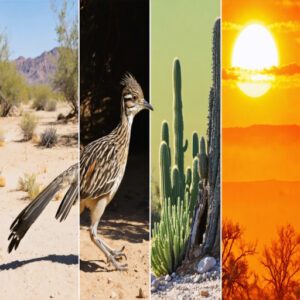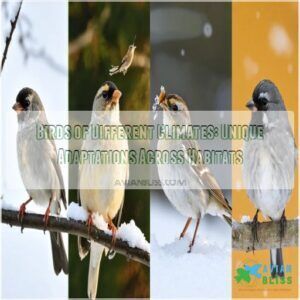This site is supported by our readers. We may earn a commission, at no cost to you, if you purchase through links.
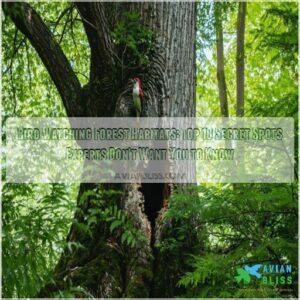
Forests with varied canopy heights, multiple layers, and diverse tree species create perfect homes for hundreds of bird species.
Oak-hickory forests support up to 200 different birds, while pine forests host around 150.
Look for larger forest blocks with minimal fragmentation for the best diversity.
Each bird has specific needs – woodpeckers love old trees with holes, while warblers prefer thick undergrowth.
The secret to spotting more forest birds isn’t just knowing where to look, but understanding how forest features create the perfect bird neighborhood.
Table Of Contents
- Key Takeaways
- Forest Bird Habitats
- Bird Species Requirements
- Threats to Forest Birds
- Forest Management Techniques
- Bird Watching Locations
- Frequently Asked Questions (FAQs)
- Where do birds live in the forest?
- What habitats do birds like?
- How do you attract birds in the forest?
- Why do birds like forests?
- How to identify bird calls in forests?
- Best times of day for forest birdwatching?
- Recommended equipment for forest bird observation?
- Seasonal migration patterns through forest corridors?
- Citizen science projects for forest bird monitoring?
- Conclusion
Key Takeaways
- You’ll find that forests with varied canopy heights, multiple layers, and diverse tree species create perfect homes for hundreds of bird species, so look for larger forest blocks with minimal fragmentation for the best diverse tree species.
- Different bird species have specific needs, like woodpeckers loving old trees with holes and warblers preferring thick undergrowth, so understanding these requirements will help you spot more birds on your next forest adventure.
- You can attract birds by creating diverse habitats, retaining snags, and planting native species that produce flowers and fruit, which benefits birds and ecosystem health in the forest ecosystem naturally.
- To make the most of your bird watching experience, you’ll need to know the best times of day, which are early morning and late afternoon when birds are most active, and have the right equipment, such as binoculars, a field guide, and a spotting scope.
Forest Bird Habitats
You’ll discover that forests are nature’s best-kept secret for bird watching, supporting more species than any other habitat type in North America.
Whether you’re exploring oak-hickory groves with their 200 different bird species or wandering through pine forests where 150 unique birds make their home, you’ll find an incredible variety of feathered friends in these woodland sanctuaries.
Forest Types and Bird Species
When you explore different Forest Types, you’ll discover that forests support more bird species than any other habitat type.
Oak-hickory forests might host up to 200 Bird Species, while coniferous stands support around 150.
You’ll notice Habitat Diversity increases as you move northeast across the US.
Forest birds like the pileated woodpecker and wood thrush each have their favorite Tree Species, making Forest Ecology fascinating for Avian Conservation enthusiasts.
Understanding bird watching habitats is essential for effective bird conservation.
Forest Structure and Composition
When you step into a forest, you’re actually walking through a multi-layered bird apartment building. The forest structure determines which feathered residents you’ll find.
Here’s what makes great forest bird habitats:
- Varied canopy heights (from 10-100+ feet)
- Mix of tree densities
- Multiple forest layers (ground, shrub, mid-story, canopy)
- Diverse tree species composition
- Natural forest regeneration patterns
Importance of Forest Size and Fragmentation
When you’re looking for prime bird watching spots, forest size matters tremendously.
Larger forest blocks support greater bird diversity, with studies showing fragmentation directly reduces species abundance.
Birds’ wing shapes affect dispersal between fragmented forests.
You’ll notice fewer forest interior specialists in fragmented areas due to edge effects, which alter microhabitats and increase predation.
The connection between patches (landscape connectivity) determines how easily birds can travel between suitable habitats, affecting their survival in fragmented landscapes.
Bird Species Requirements
You’ll find that different bird species need specific forest features, from tall tree canopies to dense undergrowth, to make their perfect home.
Whether you’re looking for woodpeckers that love old trees with holes or warblers that prefer thick bushes near the ground, understanding these requirements will help you spot more birds on your next forest adventure.
Specific Tree Types and Bird Species
You’ll discover that different tree species create unique sanctuaries for our feathered friends.
You can find products related to forest birds tree type.
In coniferous trees, you might spot pileated woodpeckers drilling for insects, while deciduous forests host melodious wood thrushes.
Oak and hickory forests support up to 200 breeding species, making them prime spots for bird watching. Pine habitats attract specialized birds like the red-cockaded woodpecker, who’s adapted to life among the towering evergreens.
Understory Vegetation and Bird Habitat
While certain trees attract specific birds, the forest floor beneath tells another story.
You’ll notice more birds in forests with rich shrub layers. Natural understory vegetation creates microhabitats where ground-feeding birds thrive.
When you’re scouting forest birding spots, look for areas with diverse vegetation density – these secret hideaways support the most varied bird communities.
Dense bushes provide essential cover for nesting, while open patches offer foraging opportunities.
Canopy and Understory Height and Density
When you’re searching for diverse bird species, pay attention to forest stratification.
Your best birding spots will have varied canopy layers and understory complexity.
Think of vertical structure as nature’s apartment building – some birds prefer the penthouse (upper canopy), while others love the ground floor (dense understory).
This complexity in tree density creates microhabitats that support greater habitat diversity throughout forest ecosystems.
Threats to Forest Birds
You’ll find your feathered friends face serious challenges from housing developments, forest fragmentation, and hungry deer that munch away their habitats.
When you’re out bird watching, you might notice fewer warblers and woodpeckers in areas where forests have been broken up into smaller patches, making it harder for birds to find safe places to nest and enough food to survive, due to forest fragmentation and the presence of hungry deer.
Residential and Commercial Development
Expanding into woodland areas, residential development silently erases essential bird habitats at an alarming rate of 3000+ acres yearly.
Learning about endangered bird conservation is essential. You’ll see four major development impacts on forest birds:
- Direct habitat conversion through urban planning
- Reduced abundance and species evenness in remaining forest patches
- Disruption of local wildlife populations
- Altered bird feeding habits near human activity
Even your backyard choices impact these delicate forest habitats!
Natural Disturbances and Habitat Fragmentation
While housing developments shrink bird habitats, nature packs its own punch too.
Natural disturbances like windstorms, fire, and ice create a double-edged sword for forest birds.
These events naturally shape forests, creating essential early-successional habitats some birds need, but when combined with human-caused fragmentation, they’re trouble.
Forest edges multiply, predators gain easier access to nests, and habitat patches become too small for forest-dependent species.
Overabundant Deer and Habitat Degradation
While habitat fragmentation shrinks bird territories, overabundant deer create another serious threat.
You’ll notice barren understories in many forests where deer populations have exploded to 222 deer per square mile.
These hungry browsers strip away the vegetation ground-nesting birds rely on, affecting everything from nesting success to food availability.
When you’re bird watching, look for signs of excessive browsing – it’s like someone vacuumed the forest floor, leading to ecosystem disruption.
Forest Management Techniques
You’ll discover that effective forest management, like thinning trees and controlled burns, creates ideal habitats where birds actually want to hang out.
These techniques mimic natural disturbances, creating diverse forest structures with varied canopy layers, snags, and down logs that provide perfect nesting spots and feeding grounds for different bird species, utilizing controlled burns.
Thinning and Prescribed Burning
When foresters thin out overcrowded stands, they’re setting the stage for healthier bird habitats.
You’ll notice more diverse vegetation after prescribed burns, which attracts a wider variety of forest birds.
Different species respond uniquely to these management techniques – while some birds decline after burning, others thrive in the newly created spaces.
Timing matters too; burns work best when scheduled shortly after thinning for ideal habitat restoration.
Understanding woodpecker species is essential for effective forest management and conservation efforts.
Creating Diverse Habitats and Bird-Friendly Landscapes
You’ll be amazed at how easy it’s to transform your land into a bird paradise.
After managing tree density, focus on creating varied layers in your forest.
Plant native flowering shrubs at different heights, mix up your tree species, and leave some open patches.
You’re not just building bird habitats – you’re crafting a living masterpiece that’ll attract diverse species year-round.
To further enhance biodiversity, consider using forest plant seeds in your reforestation efforts.
Maintaining Snags and Down Logs
You’ll be surprised how those seemingly lifeless snags and fallen logs create nature’s perfect bed-and-breakfast for forest birds.
Dead trees aren’t just forest clutter – they’re prime real estate for cavity-nesting birds and insect-feeding species.
When you’re managing your forest, leave these natural high-rises standing and let those logs lie where they fall.
They’re essential for maintaining the delicate ecosystem balance your feathered friends need.
Effective forest management often involves using proper forest tools to preserve these habitats, which is crucial for effective conservation.
Bird Watching Locations
You’ll discover hidden gems for bird watching in America’s most pristine forest habitats, from the tropical birds of Arizona’s Chiricahua Mountains to the coastal species of Maine’s Acadia National Park.
These secret locations offer you the chance to spot rare species like the elegant trogon and California spotted owl while avoiding the typical crowded tourist spots that most casual bird watchers frequent, allowing for a more intimate and pristine experience in nature, with the opportunity to see birds in their natural habitats.
National Parks and Forests
You’ll find incredible bird watching spots in America’s national parks and forests, where smart forest management meets pristine wilderness.
The Coronado National Forest in Arizona offers 13 trails where you might spot the rare elegant trogon, while Sequoia & Kings Canyon National Parks host diverse species at elevations from 1,000 to 8,000 feet.
For coastal variety, Acadia National Park’s trails deliver spectacular views and guided birdwatching tours.
These national parks support bird conservation efforts that protect numerous species and their habitats.
Mountainous Regions and Riparian Habitats
Beyond the well-trodden park trails, you’ll discover nature’s hidden treasures in mountainous regions and riparian zones.
The Santa Monica Mountains alone boast 120 bird watching trails where water sources attract diverse species.
Here’s what makes mountain ecosystems perfect for spotting elusive birds:
- Varied elevations create multiple habitat types in a small area
- Riparian zones offer year-round water access for rare species
- Mountain meadows provide critical nesting grounds, especially during spring, which is a crucial time for diverse species.
Frequently Asked Questions (FAQs)
Where do birds live in the forest?
Like intricate layers of a cake, birds inhabit various forest levels.
You’ll find them nesting in tree cavities, perching on branches, foraging in shrubs, and hunting on the forest floor.
Each species finds its niche.
What habitats do birds like?
Birds thrive in diverse habitats including forests, wetlands, grasslands, scrublands, and even urban areas.
You’ll find different species adapted to specific environments based on their food sources, nesting requirements, and protection needs, which is a key factor in their survival and diverse habitats.
How do you attract birds in the forest?
You attract birds by creating diverse habitats, retaining snags, and planting native species that produce flowers and fruit, which benefits birds and ecosystem health in the forest ecosystem naturally.
Why do birds like forests?
You’ll find 75% of bird species in deciduous forests, as they offer food, shelter, and breeding grounds, making forests a perfect haven for birds to thrive and survive.
How to identify bird calls in forests?
You’ll learn bird calls by listening, using apps, and practicing, slowly becoming a pro at identifying species in forests.
Best times of day for forest birdwatching?
You’ll spot most birds during early morning, don’t worry about waking up early, it’s worth it, as they’re most active then, and late afternoon, when they’re searching for food.
Recommended equipment for forest bird observation?
You’ll need binoculars, a field guide, and a spotting scope to observe forest birds effectively, helping you get up close and personal with these amazing creatures.
Seasonal migration patterns through forest corridors?
You’ll discover seasonal migration patterns vary, with birds traveling through forest corridors, often following food sources, and you can track their journeys, observing changes in species presence.
Citizen science projects for forest bird monitoring?
You can participate in citizen science projects, like bird counts, to monitor forest birds, helping researchers understand populations, habitats, and behaviors, and informing conservation efforts, it’s fun and easy.
Conclusion
Uncovering the secrets of bird watching forest habitats is like finding a treasure chest, you discover a world of possibilities.
You’ll find the best spots for bird watching forest habitats by understanding forest structure and composition, and how it supports a diverse range of bird species.
Making bird watching forest habitats a thrilling experience.
- https://ny.audubon.org/conservation/basics-forest-management-birds
- https://apps.fs.usda.gov/forest-atlas/lives-forest-birds.html
- https://www.birdsandblooms.com/birding/birding-basics/bird-watching-habitat/
- https://www.exploringbirds.com/posts/bird-habitats
- https://naturebackin.com/2020/07/02/for-the-birds-forest-and-woodland-habitats/

